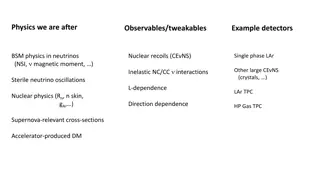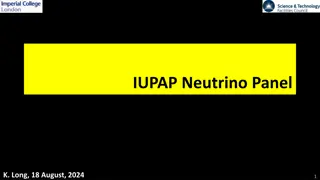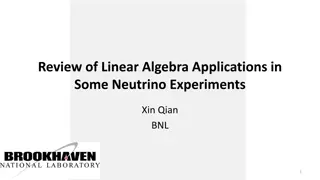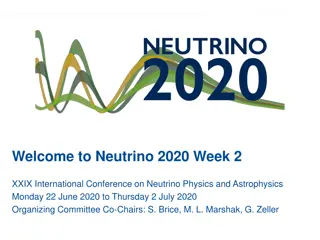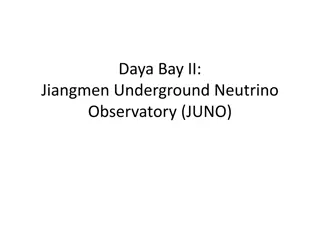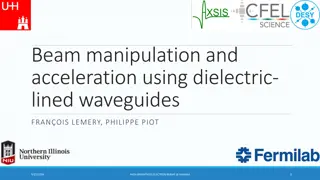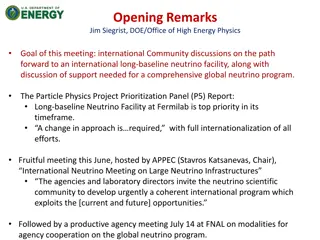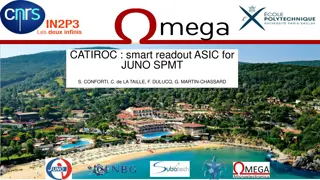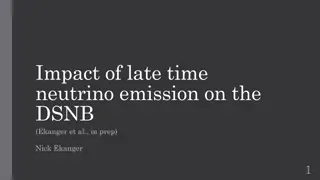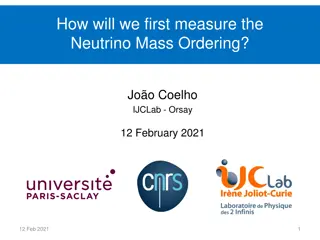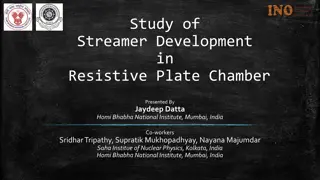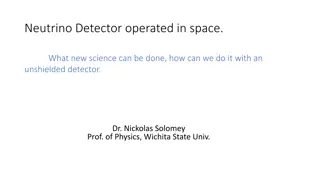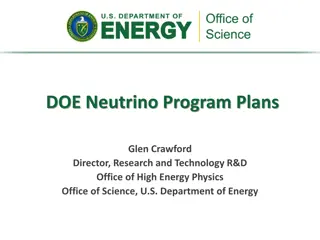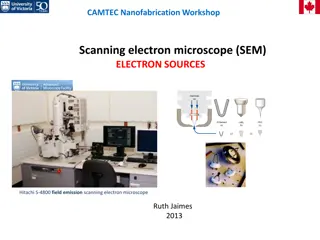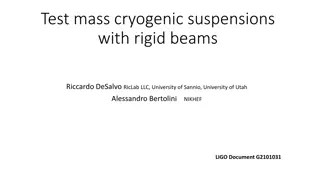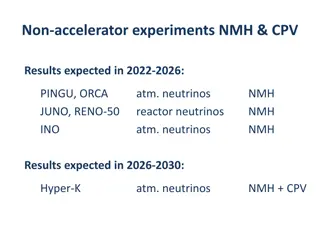Overview of Neutrino Beams in China: MOMENT Study Progress and Potential
The MOMENT study, initiated in 2013 in China, focuses on muon-decay medium baseline neutrino beam facility development. Using a Continuous Wave (CW) proton linac, the project aims to achieve 15 MW beam power for neutrino cross-section measurements and CP phase study. Recent progress includes the successful development of the China-ADS linac and ongoing efforts at IHEP and IMP. The project's physics goals have evolved, attracting international collaborators for accelerator-based neutrino experiments.
Download Presentation

Please find below an Image/Link to download the presentation.
The content on the website is provided AS IS for your information and personal use only. It may not be sold, licensed, or shared on other websites without obtaining consent from the author.If you encounter any issues during the download, it is possible that the publisher has removed the file from their server.
You are allowed to download the files provided on this website for personal or commercial use, subject to the condition that they are used lawfully. All files are the property of their respective owners.
The content on the website is provided AS IS for your information and personal use only. It may not be sold, licensed, or shared on other websites without obtaining consent from the author.
E N D
Presentation Transcript
Neutrino beams in China Jingyu Tang Institute of High Energy Physics, CAS NNN16, IHEP, Beijing, Nov. 3-5, 2016
Outline Brief introduction to the MOMENT Recent study progress Physics potential MOMENT R&D and neutrino cross-section measurements at CSNS/EMuS Summary
MOMENT study MOMENT: A muon-decay medium baseline neutrino beam facility MOMENT was launched in 2013 as the third phase of neutrino experiments in China, following Daya Bay and JUNO Originally as a dedicated machine to measure CP phase in the future, if there are still the needs then. Physics goals should be modified along with the neutrino physics development. As a driving force to attract researchers from China as well international collaborators to work on neutrino experiments based on accelerators
Features: Using a CW proton linac as the proton driver: 15 MW China-ADS linac development Fluidized target in high-field SC solenoid Muon transport and decay channel (Pure + or - decay, managed beam) Also possible with -decayed beam and Decay-at-Rest neutrinos + ( )
Proton driver Design goal: Beam power: 15 MW Beam energy: 1.5 GeV Beam current: 10 mA Using the China-ADS linac or a dedicated linac with large simplification (much less redundancy) 3.2-MeV RFQ (room-temperature) Three sections SC spoke cavities (160 MeV) Two sections SC elliptical cavities (1.5 GeV) In total, 196 SC cavities in 42 cryostats, linac length: ~ 300 m 325 MHz 650 MHz HEBT RFQ 325 MHz Spoke012 12 cavities Spoke021 32 cavities Spoke040 42 cavities Elliptical 063 30 cavities Elliptical 082 80 cavities ECR Target LEBT MEBT1 160 MeV 35 keV 3.2 MeV 40 MeV 409 MeV 1500 MeV 10MeV
Estimate of neutrino flux POT (5000 h): 1.125 1024proton/year Muon yield: 1.62 10-2 /proton Total neutrino yield: 4.8 10-3 /proton (in pair) 5.4 1021 /year (in pair) (NF: 1.1 1021 /year ) Neutrino flux at detector: dependent on the distance 4.7 1011 /m2/year (@150 km)
ADS linac development Parallel efforts at IHEP and IMP on the linac front (RFQ + low- cavities, 10 MeV) Very successful from both teams (different schemes) RFQ CW operation (IMP: 100%, IHEP: 99%) Low- superconducting cavities (10 MeV at IHEP, world first; 5 MeV at IMP, 10 mA; both pulsed) Prototypes of different SC cavities (Spoke, HWR, Elliptical) Second ADS phase (CIADS) approved Will be in Huizhou, Guangdong (not far from Daya Bay) 250 MeV -10 mA, CW mode Test-stand at IMP
Target Station Further optimization of the mercury jet target design More interests in developing fluidized granular target in collaborating with the C-ADS target team, and also waiting for study result with fluidized tungsten-powder target in Europe
Schematic of a waterfall-like granular target Preliminary study shows good heat transfer and pion capture efficiency Implantation method (such as cutting slots in the inner shielding) is still under development
Charge selection A selection section to select +/ + from -/ -, as either + beam or - beam is used for producing the required neutrinos Reverse the fields when changing from + to - Also for removing very energetic pions who still survive Very difficult due to extremely large beam emittance (T/L) Two schemes: based on 3 SC dipoles with strong gradient (or FFAG), and bent SC solenoids Present study shows Dipole+solenoid solution works for smaller emittance, bent solenoid solution works for very large emittance
Spent protons extraction Features Very important to avoid huge heat deposit and radiation in the target station (also meaningful for NF) Spent protons can be reused Very difficult in practice Method Extract only high-energy protons (scattered from target) Collimation and bent solenoids (+dipole field)
Physics potential in CP Detecting CP-violating phase in the lepton sector Absolute measurement: P( e) Relative measurement: P( e)-P( e) Advantages of MOMENT High intensity neutrino beam : >1021 /year Relative low energy (~300 MeV) and short baseline (~150 km) Minimum interference from matter effect Low 0background Muon decay neutrinos Measure multiple oscillation channels at the same time Low beam intrinsic background Requirement to the detector e/ identification Neutrino/antineutrino identification 15
Signal and background Detector options Liquid scintillator Gd-doped water Cherenkov detector Signals ( + decay, 5,000kton year, 100% efficiency) IBD: 435 (easy to be identified with neutron tagging) e CC: ~1,600 (large contamination of e without magnetized detector) Oscillation signal of -decay is ~1/3 compared to +decay Another calculation can be found in arXiv:1511.02859 IBD spectrum in the detector Major background Atmospheric neutrinos Charge mis-identification 16
Perspective e/ identification in the liquid scintillator MC studies are ongoing e+ + Scintillation light Cherenkov light Cherenkov ring Improve charge identification A large magnetized detector? Reduce atmospheric background Reconstructing neutrino direction Sending neutrino in short bunches (arXiv:1511.02859)? Not realistic in ADS-type accelerator (CW beam) Direction of e+from IBD 17
Another possibility Make use of decay-at-rest neutrinos? DAE ALUS MOMENT-DAR PRL 104, 141802 (2010) 18
Other physics potentials Search for sterile neutrinos DAR at the two beam dumps: target station and beam dump Neutrino cross-section measurement Both -decay and -decay neutrinos in 0-500 MeV Muon physics Very high intensity DC muon beam
MOMENT R&D and neutrino cross- section measurements at CSNS/EMuS
EMuS at CSNS We plan to build an experimental muon source (EMuS) at China Spallation Neutron Source (CSNS). CSNS is under construction, expected to complete in March 2018, 100 kW at Phase I and 500 kW at Phase II EMuS will use 4% beam power to produce intense muon beams for MOMENT R&D studies and SR multidisciplinary applications. Potentially it may be also used for neutrino cross-section measurements and muon physics. MOMENT R&D studies include muon capture in high-field, charge selection, spent proton extraction etc. Present EMuS study is supported by an NSFC fund for R&D and prototypes
2009 5 9 22
Beamline layout of EMuS and operation modes Beam operation modes (independent): 1. Neutrino mode a) Wide energy spectra b) Ref. P =300-500MeV/c 2. Surface muon mode a) Momentum spread: b) Ref. P =29MeV/c 5% 3. Decay muon mode a) Momentum spread: b) Ref. P =100-200MeV/c 10% 23
-fluxes for neutrino beam - 100 % +, -selection (Decay channel: ~25 m, Aperture: 30 cm ) Detector 3 m upstream of the DT Detector 3 m upstream of the DT - , <E > ~ 200 MeV neutrino beam anti-neutrino beam - - e e neutrino beam anti-neutrino beam 2-5% stat. error 108p.o.t. (x1014) / m2 / 200 days (x1014) / m2 / 200 days % % - e e 260 97.5 2.2 2.5 - 3.3 1.25 85 95.5 - 3.3 1.25 - - 0.0002 - 1.8 2 24
CC-events (water target ) , <E> ~ 300 MeV - neutrino beam anti-neutrino beam e - - e neutrino beam anti-neutrino beam preliminary CC / ton / 200 days at 3m CC / ton / 200 days at 3m % % - 1034 98.6 5.6 7.3 - 2.9 0.3 71.5 90 e 11.3 1.1 - - e 0.00007 - 2.1 2.7 25
cross-section measurements World unique at energy of 300 MeV 1000 CC events / ton / 200 days (3.2x1020p.o.t) at 3 m Possible upgrade: beam power, higher capture field (-> 25000 CC events / ton / 200 days at 3 m) Might be interesting to explore sterile neutrinos (L/E ~ 1 m/MeV at 2500 m) similar to LSND and MiniBooNE 26
Summary MOMENT is a driving force to attract Chinese researchers to collaborate on neutrino experiments based on accelerator-based neutrino beams Also participating international projects: LBNF, MICE, Current studies focus on Suitable detector and physics potential with different neutrino sources Fluidized granular target and spent protons extraction Charge selection methods Some R&D will be done at CSNS/EMuS It is also possible to carry out neutrino cross-section measurements and sterile neutrino search at EMuS



